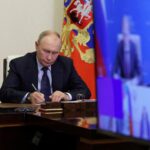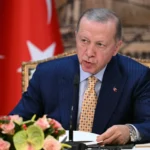Whether the topic of the day is Chinese spy balloons or American AI breakthroughs, Washington and Beijing are increasingly seeing world events through the lens of a “tech war.” This ever intensifying rivalry is usually framed as “America vs. China,” but that misses a key point: America is not alone.
America’s greatest competitive advantage over China is not wealth or weapons, but the fact that America has a lot of close friends, and China has none. In fact, The only country that has signed a treaty to support China in the event of a war is North Korea, an impoverished pariah state that deliberately schedules nuclear tests and missile launches to embarrass China during high-profile diplomatic summits. Treaty or no, few would describe China and North Korea as friends.
Attorney Gloria Allred Comments After Harvey Weinstein Gets 16 Years for Rape, Sexual Assault
It’s good to have friends, especially since many of America’s are world leaders in technologies of major strategic and geopolitical importance, including semiconductors. Most Americans are at least vaguely aware that Saudi Arabia is a key player in the global economy because it produces more than 10% of the world’s oil, but far fewer know that Taiwan produces more than 90% of the world’s most advanced semiconductor computer chips or that a single company based in the Netherlands, ASML, produces 100% of the most advanced lithography machines that are irreplaceable equipment for computer chip factories. Today, computer chips are vital inputs not only to datacenters and smartphones, but also to cars, critical infrastructure and even household appliances like washing machines. As the global economy has become more and more digitized, it has also grown more and more dependent upon chips. It’s for good reason that national security experts routinely declare semiconductors to be “the new oil” when it comes to geopolitics and international security.
Which brings us to the Biden Administration’s remarkable string of tech diplomacy achievements over the past several months. On October 7, 2022, the Biden Administration unilaterally imposed a set of export controls that restrict sales to China of advanced computer chips designed for running Artificial Intelligence applications and military supercomputers as well as the manufacturing equipment for making those chips. Since U.S. companies design more than 95% of the AI chips that are used in China, and also produce manufacturing equipment that is used in every single Chinese chip factory, these export controls pose an extraordinary obstacle to China’s ambitions to lead the world in AI technology and to achieve self-sufficiency in semiconductors.
However, the export controls were also a major diplomatic gamble. If the U.S. forced U.S. industry to stop selling advanced chips and chip-making equipment to China, only for other countries to step in and replace the United States, the policy would have dealt a major blow to U.S. industry. The U.S. would suffer a huge loss of market share and revenue in China and gain in return only a fleeting national security benefit, perhaps setting China back only a matter of months. The policy’s success depended entirely upon persuading U.S. allies—particularly Taiwan, the Netherlands, and Japan—to follow the U.S. lead and adopt similar export control regulations.
Taiwan was the first to signal that it was onboard with the new restrictions, announcing on October 8th that it would no longer allow Chinese chip design companies to contract with Taiwanese chip factories to produce chips that could replace those that America is no longer allowing to be sold to China. China has world class chip designers, but its chip factories are significantly behind the state of the art in Taiwan. Taiwan has ample reason to support Washington, both because Joe Biden has been more open than any American president in decades about defending Taiwan from possible Chinese invasion and also because the Taiwanese semiconductor industry has also been a serious victim of Chinese government-backed industrial espionage and illegal talent poaching campaigns. Taiwan’s government knows that China’s goal is to end its strategic semiconductor dependence upon Taiwan—which Taiwan refers to as its “silicon shield”—as fast as possible. Naturally, Taiwan is onboard with U.S. policies that aim to prevent that, though they generally prefer to be as quiet as possible about it to minimize the blowback from China.
Like Taiwan, Japan and the Netherlands are also global giants in the semiconductor industry. They, along with the United States, dominate the market for the astonishingly complicated equipment that is a vital component of every chip factory on Earth. While there are Chinese companies that produce semiconductor manufacturing equipment, they only produce a fraction of the many different types of equipment that are required to produce chips, and the equipment that Chinese companies do produce is far behind the state of the art in the U.S., the Netherlands, and Japan. The most advanced Dutch lithography machines, for example, contain more than 100,000 parts, cost more than $340 million each, and rival the James Webb Space telescope or Large Hadron Collider in terms of technological complexity.
With the October 7th export controls, the U.S. cut China off from the most advanced U.S. semiconductor manufacturing equipment, but this would be a fleeting, hollow victory if Japan and the Netherlands did not immediately follow suit. There are some kinds of equipment that only U.S. companies can currently make, but Dutch and Japanese companies produce equivalently advanced machines in highly related technical disciplines. In other words, they could develop new products to replace U.S. tech relatively quickly—at least a decade faster than China by itself—if the reward was guaranteed monopoly access to a large Chinese customer base.
Unfortunately for China, Japan, and the Netherlands are not going to do that. In late January, the Biden Administration secured a remarkable diplomatic victory: a deal with the Netherlands and Japan to establish multilateral semiconductor technology export controls on China. Though the specific details of the deal will take months of continued negotiation to finalize and likely will not be known until the Netherlands and Japan publish their updated export control regulations, two essential details are now known: Japan and the Netherlands will not allow their equipment companies to replace U.S. industry for sales to China, and the countries will broaden the set of export control restricted equipment to include items that U.S. industry does not make, including advanced lithography equipment. If adequately enforced, the deal will likely add a decade or two to the timeline for China’s plans for semiconductor self-sufficiency—and China may now never reach it at all.
Like Taiwan, Japanese and Dutch companies have been victims of China’s government-backed industrial espionage for semiconductor technology. And while they have historically feared Chinese retaliation for any measures taken to stop such provocations, they also have had to reassess their prior foreign policy positions after Russia’s invasion of Ukraine. Chinese support to Russia government has had disastrous consequences for China’s global image.
Just as important, though, Taiwan, Japan, and the Netherlands share America’s democratic values and interest in a peaceful, rules-based international order. For the most part, the U.S. did not reach this export controls agreement through diplomatic carrots and sticks, but through genuine persuasion on the merits of the policy as well as a genuine willingness to be persuaded when the allies made good points. For months before and after October 7th, U.S. diplomats have been engaging with their foreign counterparts, listening closely to concerns, and working diligently and collaboratively to address those concerns.
This is a hallmark of the Biden Administration’s approach to negotiation not only in foreign policy, but also domestically. After the 2021 passage of the bipartisan infrastructure bill in Congress, Senator Mitt Romney praised the Biden Administration’s earnest collaborative approach: “You can tell the difference between an adversarial negotiation and a collaborative one,” he said. “In this case, when one side had a problem, the other side tried to solve the problem, rather than to walk away from the table.”
Obviously, that’s not the right negotiating style for every situation. But nothing works better when the goal requires deserving and preserving the trust of friends, and it’s good to have friends.
Source: Time















